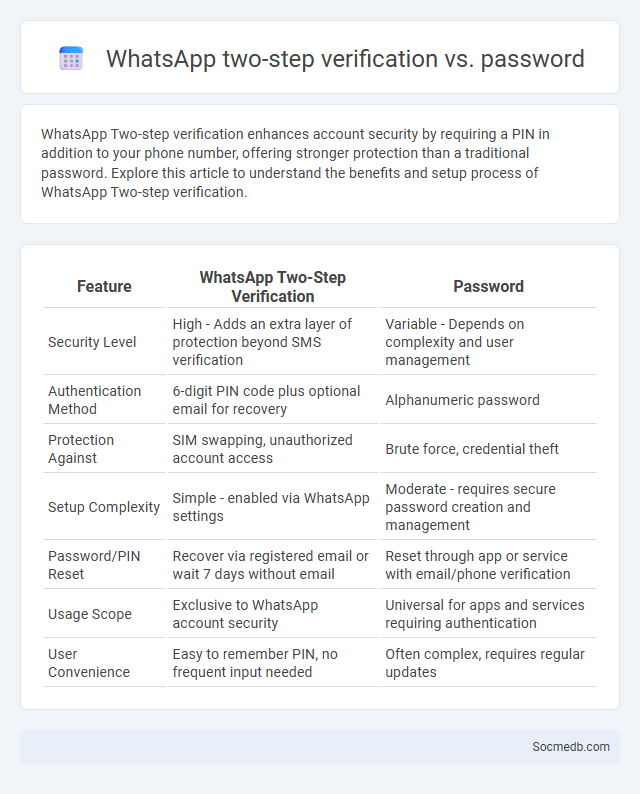
Photo illustration: WhatsApp Two-step verification vs Password
WhatsApp Two-step verification enhances account security by requiring a PIN in addition to your phone number, offering stronger protection than a traditional password. Explore this article to understand the benefits and setup process of WhatsApp Two-step verification.
Table of Comparison
| Feature | WhatsApp Two-Step Verification | Password |
|---|---|---|
| Security Level | High - Adds an extra layer of protection beyond SMS verification | Variable - Depends on complexity and user management |
| Authentication Method | 6-digit PIN code plus optional email for recovery | Alphanumeric password |
| Protection Against | SIM swapping, unauthorized account access | Brute force, credential theft |
| Setup Complexity | Simple - enabled via WhatsApp settings | Moderate - requires secure password creation and management |
| Password/PIN Reset | Recover via registered email or wait 7 days without email | Reset through app or service with email/phone verification |
| Usage Scope | Exclusive to WhatsApp account security | Universal for apps and services requiring authentication |
| User Convenience | Easy to remember PIN, no frequent input needed | Often complex, requires regular updates |
Introduction to WhatsApp Security Features
WhatsApp employs end-to-end encryption to secure your messages, ensuring that only you and the recipient can read the content. The app also offers two-step verification for an extra layer of protection, preventing unauthorized access to your account. Privacy settings allow you to control who can see your profile information and status updates, enhancing overall security on the platform.
What is WhatsApp Two-Step Verification?
WhatsApp Two-Step Verification is a security feature that adds an extra layer of protection to your account by requiring a six-digit PIN when registering your phone number with WhatsApp again. This verification process helps prevent unauthorized access, even if someone gains access to your SIM card or phone number. Enabling Two-Step Verification ensures Your personal messages and data remain safer on the platform.
Understanding Traditional Password Protection
Traditional password protection relies on alphanumeric combinations to secure social media accounts, often vulnerable to brute force attacks and phishing scams. Despite widespread use, weak or reused passwords expose users to data breaches and unauthorized access. Implementing multi-factor authentication and regularly updating passwords significantly enhances security beyond basic traditional methods.
How Does Password-Based Security Work?
Password-based security protects your social media accounts by requiring a unique secret code to verify your identity before granting access. When you create an account, your password is stored in an encrypted format, which social media platforms compare against during login attempts without revealing the actual password. This method ensures that only you can access your personal information and content, safeguarding against unauthorized entry.
Two-Step Verification: Definition and Benefits
Two-step verification enhances social media account security by requiring users to provide two forms of identification before access is granted, typically combining a password with a temporary code sent via SMS or authenticator apps. This authentication method significantly reduces the risk of unauthorized access, protecting personal data from phishing attacks and hacking attempts. Enabling two-step verification on platforms like Facebook, Instagram, and Twitter strengthens account protection and fosters safer online interactions.
WhatsApp Two-Step Verification vs. Password: Key Differences
WhatsApp Two-Step Verification enhances your account security by requiring a six-digit PIN in addition to your phone number, making unauthorized access significantly harder. Unlike traditional passwords, this method ties security directly to your device and includes an optional email for recovery, reducing the risk of forgotten credentials. Your data remains safer with this layered approach, as it prevents access even if your SIM card is compromised or someone tries to clone your account.
Security Strength: Two-Step Verification vs. Password
Two-step verification significantly enhances social media security by requiring an additional authentication factor beyond your password, such as a one-time code sent to your mobile device. This layered protection reduces the risk of unauthorized access caused by stolen or weak passwords, safeguarding your personal information and online identity. Enabling two-step verification ensures your social media accounts have a stronger defense against cyber threats compared to relying solely on traditional password security.
Usability and User Experience Comparison
Social media platforms prioritize usability and user experience through intuitive interfaces, fast loading times, and seamless content navigation. Features such as personalized feeds, easy sharing options, and interactive elements enhance user engagement and satisfaction. Comparative studies highlight that platforms with minimal clutter, adaptive design, and consistent updates tend to retain users more effectively.
Potential Vulnerabilities and Risks
Social media platforms expose Your personal data to potential vulnerabilities such as identity theft, phishing attacks, and cyberbullying. Weak privacy settings and unverified third-party applications increase the risk of unauthorized access and data breaches. Regularly updating security measures and being cautious about shared information can help mitigate these risks.
Which Security Method Should You Choose?
Choosing the right social media security method depends on factors like platform vulnerability, account sensitivity, and personal privacy needs. Two-factor authentication (2FA) is highly recommended, combining passwords with a secondary verification such as SMS codes or authentication apps for enhanced protection. Regularly updating passwords, enabling login alerts, and reviewing connected apps also strengthen your security posture against cyber threats.
 socmedb.com
socmedb.com